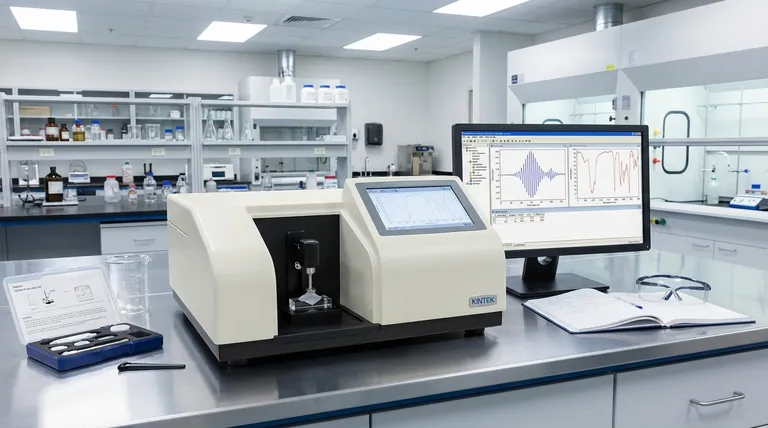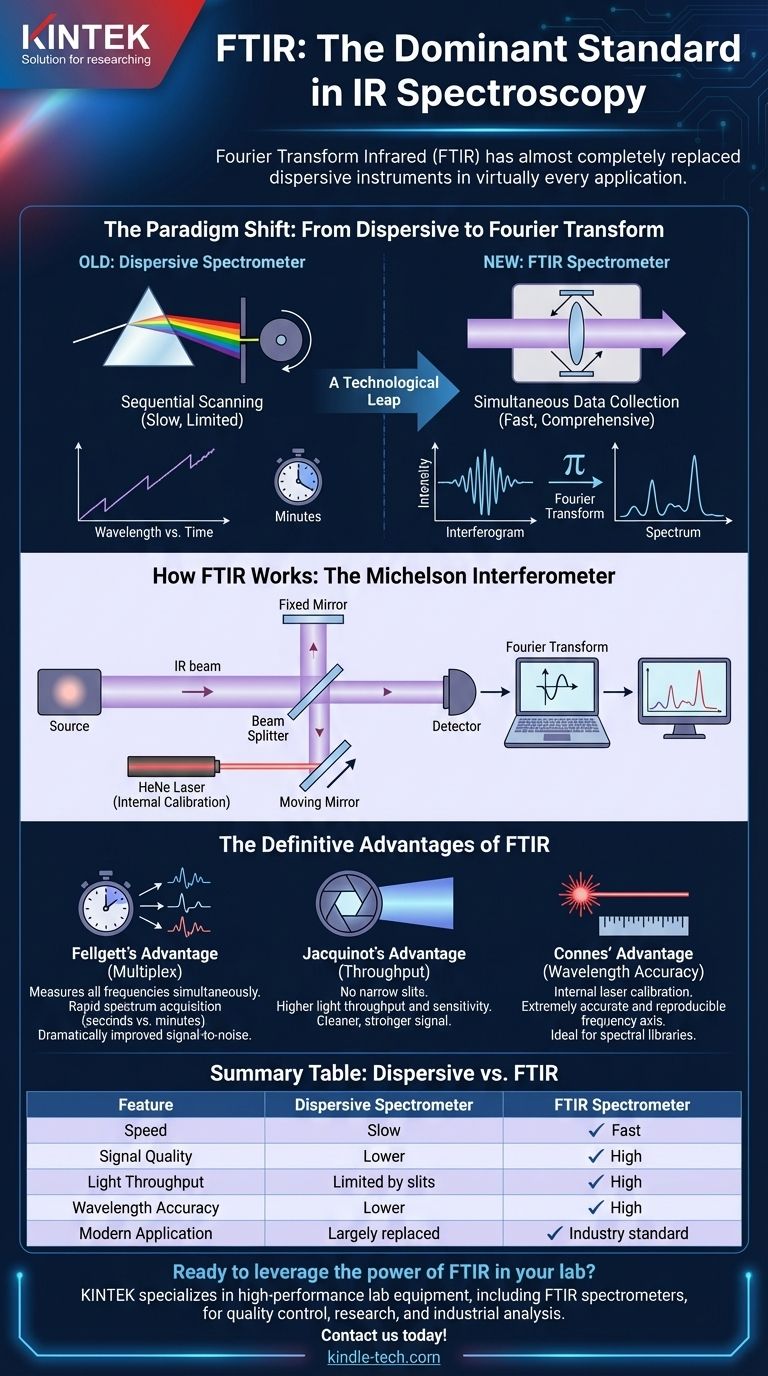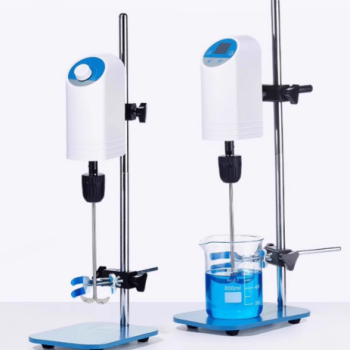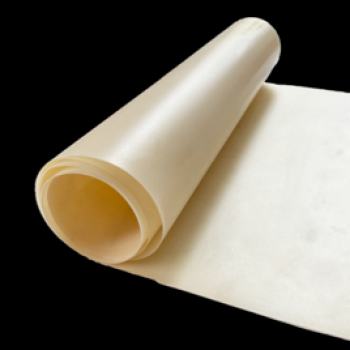By far, the most commonly used type of infrared spectrometer is the Fourier Transform Infrared (FTIR) spectrometer. It has almost completely replaced the older dispersive-type instruments in virtually every application, from industrial quality control to academic research. This dominance is due to its fundamentally superior method of data acquisition, which provides significant advantages in speed, accuracy, and signal quality.
The core reason FTIR spectrometers dominate is not just a hardware upgrade, but a paradigm shift in measurement. Instead of measuring one wavelength at a time, an FTIR collects data from all wavelengths simultaneously, then uses a mathematical process—the Fourier transform—to generate the spectrum, resulting in dramatically faster and higher-quality results.

From Dispersive to Fourier Transform: A Technological Leap
To understand why FTIR is the standard, it helps to first understand the technology it replaced. The evolution from dispersive to Fourier Transform instruments marks a pivotal moment in the history of chemical analysis.
The Old Method: Dispersive Spectrometers
Older IR spectrometers were dispersive. They used a component like a prism or a diffraction grating to physically separate the infrared light into its constituent frequencies.
The instrument would then rotate this grating, allowing only a very narrow band of frequencies to pass through a slit and the sample to reach the detector at any given moment. To generate a full spectrum, it had to slowly scan through the entire frequency range, one piece at a time. This process was extremely slow and inefficient.
The New Standard: Fourier Transform Spectrometers
An FTIR spectrometer works on a completely different principle. It directs the entire beam of IR radiation, containing all frequencies, through the sample at once. The "magic" happens inside a component called an interferometer.
This fundamental change in approach—collecting all data simultaneously—is what gives FTIR its defining advantages.
How an FTIR Spectrometer Actually Works
The heart of an FTIR is the Michelson interferometer. Understanding its function is key to understanding the power of the technique.
The Core Component: The Interferometer
An interferometer splits a beam of light into two, sends them down different paths, and then recombines them. In an FTIR, a beam splitter sends about half the light to a fixed mirror and the other half to a moving mirror.
The two beams reflect off their respective mirrors and are recombined at the beam splitter. Because one mirror's path length is changing, the two beams interfere with each other either constructively (creating a strong signal) or destructively (canceling each other out).
Capturing the Interferogram
As the moving mirror travels, the detector records a complex signal showing intensity versus the mirror's position. This signal, called an interferogram, is not a spectrum. Instead, it is a composite waveform containing all the spectral information encoded within it.
At the point where both path lengths are identical (the Zero Path Difference or ZPD), all frequencies are in phase, and the signal is at a maximum. As the mirror moves, the different frequencies go in and out of phase, creating the unique interferogram.
The Power of the Fourier Transform
The interferogram (a signal in the distance or "time" domain) is then converted into a familiar spectrum (intensity vs. wavenumber in the frequency domain) using a computer and a mathematical algorithm called the Fourier Transform.
This process digitally "unscrambles" the encoded interferogram, calculating the intensity of each individual frequency of light that passed through the sample.
The Definitive Advantages of FTIR
The shift to the FTIR method provides three widely recognized and transformative benefits over the older dispersive technique.
Fellgett's Advantage (The Multiplex Advantage)
This is the most significant benefit. Since an FTIR measures all frequencies simultaneously rather than scanning them one by one, it can acquire a complete spectrum in seconds. A dispersive instrument might take many minutes for the same task. This speed allows for signal averaging, where multiple scans are collected and averaged to dramatically improve the signal-to-noise ratio.
Jacquinot's Advantage (The Throughput Advantage)
Dispersive instruments require narrow slits to ensure only a small band of frequencies hits the detector, which severely limits the amount of light (energy) passing through the instrument. FTIRs have no such slits, allowing much higher light throughput. This results in a cleaner, stronger signal and better overall sensitivity.
Connes' Advantage (The Wavelength Accuracy Advantage)
The position of the moving mirror in an FTIR is continuously monitored by a precise helium-neon (HeNe) laser. This internal laser calibration ensures that the frequency axis of the spectrum is extremely accurate and reproducible from scan to scan and instrument to instrument. This makes FTIR spectra highly reliable and ideal for use with spectral libraries.
Understanding the Trade-offs
While the FTIR is dominant, it is essential to understand its context and limitations as an analytical tool.
Higher Complexity
The combination of precision moving optics (the interferometer) and the computational demands of the Fourier transform makes an FTIR inherently more complex than simpler photometric instruments. However, modern engineering has made them exceptionally robust and reliable for routine use.
Sensitivity to Environment
Because the interferometer relies on optical paths measured in fractions of a wavelength of light, it can be sensitive to physical vibrations. Modern instruments incorporate sophisticated dampening, but a stable lab bench is still a requirement.
Unsuitability for Certain Samples
The primary limitation is often related to IR spectroscopy itself, not just the FTIR instrument. The technique is ineffective for analyzing samples in aqueous solutions, as water is a very strong IR absorber and its broad signals will overwhelm the signal from the analyte. Similarly, it cannot detect single atoms (like noble gases) or homonuclear diatomic molecules (like N₂ or O₂) because they have no dipole moment change during vibration.
Making the Right Choice for Your Goal
The dominance of FTIR is a direct result of its superior performance. When considering infrared spectroscopy, the choice is less about if you should use an FTIR and more about how you will use it.
- If your primary focus is routine chemical identification or quality control: The FTIR is your workhorse due to its speed, reliability, and the ability to compare your results against vast commercial spectral libraries.
- If your primary focus is quantitative analysis: The high signal-to-noise ratio and reproducibility of FTIR make it an excellent tool for accurately measuring the concentration of a component in a mixture.
- If your primary focus is studying chemical reactions or transient states: The rapid-scanning capability of an FTIR is essential for capturing spectral changes on a timescale of seconds or even milliseconds.
- If your primary focus is teaching modern analytical chemistry: A robust, user-friendly FTIR is the industry standard and the correct tool for preparing students for their future careers.
Ultimately, understanding the principles behind the FTIR spectrometer empowers you to leverage its full analytical power for your specific application.
Summary Table:
| Feature | Dispersive Spectrometer | FTIR Spectrometer |
|---|---|---|
| Speed | Slow (minutes per scan) | Fast (seconds per scan) |
| Signal Quality | Lower signal-to-noise | High signal-to-noise (Fellgett's Advantage) |
| Light Throughput | Limited by slits | High (Jacquinot's Advantage) |
| Wavelength Accuracy | Lower | High (Connes' Advantage) |
| Modern Application | Largely replaced | Industry standard |
Ready to leverage the power of FTIR in your lab?
KINTEK specializes in providing high-performance lab equipment, including FTIR spectrometers, to meet the rigorous demands of modern laboratories. Whether you're in quality control, academic research, or industrial analysis, our solutions deliver the speed, accuracy, and reliability you need.
Contact us today to find the perfect FTIR spectrometer for your application and see how we can enhance your analytical capabilities.
Get in touch with our experts now!
Visual Guide

Related Products
- High Performance Laboratory Stirrers for Diverse Applications
- Customizable PEM Electrolysis Cells for Diverse Research Applications
- Optical Window Glass Substrate Wafer Barium Fluoride BaF2 Substrate Window
- Cylindrical Resonator MPCVD Machine System Reactor for Microwave Plasma Chemical Vapor Deposition and Lab Diamond Growth
- Anion Exchange Membrane for Laboratory Use
People Also Ask
- What temperature should a hot plate be? Achieve Safe and Precise Heating for Your Lab
- Can you control the temperature of a hot plate? Master Precise Heating for Your Lab Work
- What is the use of evaporator in laboratory? Gentle Solvent Removal for Sensitive Samples
- How do I control the temperature of my induction heater? Master Precise Power & Feedback Control
- Why is grinding important in laboratory? Ensure Sample Homogeneity for Accurate Results



















